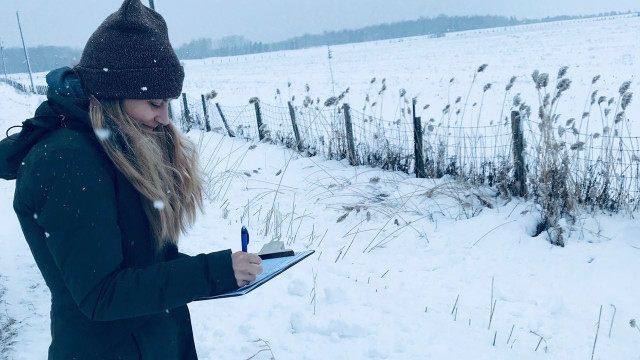By Michael Hindy
From the unique ice formations on our Great Lakes, to the countless miles of cross country and snowmobile trails, the Upper Peninsula holds an outstanding natural beauty for all to enjoy. Did you know that while you’re enjoying the beauty of our Upper Peninsula you could be making a difference simply by keeping an eye out for invasive species?
Here in our beautiful U.P., we can enjoy more than 3,000 miles of groomed snowmobile trails that cover nearly 36,000 acres. This comprehensive trail system creates an extensive network for detecting the spread of invasive species. For example, if one snowmobiler who enjoyed a 50-mile ride kept their eye out for invasive species, they would help protect nearly 600 acres from the spread of invasive species.
While the deep snow may hide and cover many herbaceous invasive species until spring, several other invasive species such as invasive phragmites and buckthorns can still be identified during the winter months.
When looking for invasive phragmites, look for a tall grass that can be over 6 feet tall along shorelines and in wetlands. During the winter, the above-water biomass of the phragmites plant will be mostly or entirely brown, with intact fluffy seed heads. The invasive phragmites plant tends to grow in very dense patches that eliminate natural refuges for fish and wildlife, and the dense growth of this species allows it to maintain a mostly upright position amongst the weight of the snow. If you are enjoying winter recreational activities such as snowshoeing, cross country skiing, snowmobiling, or ice fishing and spot invasive phragmites, reporting the sighting of the invasive phragmites to the Three Shores CISMA can go a long way in preventing the spread of the species.
If you’re enjoying the beauty of the forests in the U.P. during winter, keep an eye out for invasive buckthorns. Buckthorns grow in very dense formations that prevent the growth of understory vegetation and create a wasteland for wildlife habitat. Buckthorns grow as small trees or shrubs that can grow up to 20 feet tall with a trunk of up to 10 inches in diameter. One species of invasive buckthorn, the common buckthorn, grows very sharp thorns. The outer bark of invasive buckthorns appears very smooth and gray/brown in color, while the inner layer of bark is a bright orange in color.
Here at the Three Shores CISMA, we are dedicated to stopping the spread of invasive species throughout Chippewa, Luce, and Mackinac counties. If you spot any invasive species while enjoying the wonders of our Upper Peninsula winters, please contact your Three Shores CISMA at threeshorescisma@gmail.com or by calling 906-630-7139.
If you would like any more information on the identification or management of invasive species, the Three Shores CISMA has free resources we will happily distribute to you.
Thank you for continuing to fight against the threat of invasive species.
Michael Hindy is the Three Shores CISMA coordinator for the Chippewa Luce Mackinac Conservation District.












